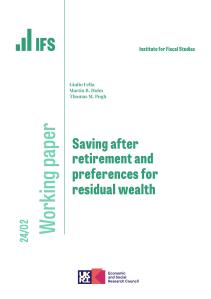On Tuesday (12 September), the Office for National Statistics will release its estimate for average earnings growth over the three months from May to July 2023 compared with the same months in 2022. This figure is likely to determine next April’s increase in the state pension for the UK’s 12 million pensioners, as it is typically used as the measure of earnings for the pensions triple lock, and because it is likely to be above both 2.5% and CPI inflation in September.
New IFS analysis shows the triple lock has by now raised state pension spending by around £11 billion a year compared with what spending would be if the pension had risen in line with either prices or earnings since 2010.
Our calculations for a plausible range of outcomes (occurring 80% of the time) show that maintaining the triple lock could increase spending by anywhere between a further £5 billion and £45 billion per year (in today’s terms) by 2050. This range is so large because of the uncertainty over the path of the state pension that the triple lock creates, which makes it very difficult for either the government or future pensioners to plan their finances.
The new IFS report released today, part of the Pensions Review in partnership with abrdn Financial Fairness Trust, finds that:
- The new state pension, which most people approaching the state pension age will receive in full, is now worth as much as a share of mean full-time earnings (25%) as the basic state pension was when price indexation was introduced and the link between the basic state pension and average earnings was broken in 1980.
- If the triple lock had not been in place since 2011, but instead the state pension had risen in line with inflation (which has been slightly higher than earnings growth), a full new state pension would now be worth around £180 per week, 11% less than its current value of £204 per week.
- The counterpart to this is considerably higher state pension spending. The 13 years of the triple lock has increased state pension spending by £11 billion per year relative to either price or earnings indexation.
- The triple lock generates considerable uncertainty for individuals regarding the state pension they might receive in the future. A reasonable range (occurring 80% of the time) for the value of the state pension in 2050 is between 26% and 32% of mean full-time earnings. In today’s terms, this would mean a range of £10,900 to £13,400 per year – a difference of £2,500 per year. This uncertainty over the value of the state pension makes it harder for people to plan for retirement.
- The uncertainty around the future level of the state pension means that there is also significant uncertainty in the future cost of providing the state pension. The triple lock might increase the cost of providing the state pension to such a great extent that it could also lead to other reforms to control spending, such as a much higher state pension age, which would be especially disadvantageous to poorer and less healthy people approaching pension age.
Heidi Karjalainen, one of the authors of the report and a Research Economist at IFS, said:
‘The triple lock makes it especially hard to know how much you might receive from a state pension and how much the state pension will cost the state in the future. An additional real risk is that retaining the triple lock for too long increases state pension spending so significantly that it leads to insurmountable pressure for a much higher state pension age. This would particularly affect people with poorer health who struggle to remain in employment until they reach state pension age.’










